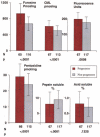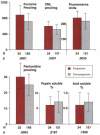Glycation and carboxymethyllysine levels in skin collagen predict the risk of future 10-year progression of diabetic retinopathy and nephropathy in the diabetes control and complications trial and epidemiology of diabetes interventions and complications participants with type 1 diabetes
- PMID: 16249432
- PMCID: PMC2622724
- DOI: 10.2337/diabetes.54.11.3103
Glycation and carboxymethyllysine levels in skin collagen predict the risk of future 10-year progression of diabetic retinopathy and nephropathy in the diabetes control and complications trial and epidemiology of diabetes interventions and complications participants with type 1 diabetes
Abstract
Several mechanistic pathways linking hyperglycemia to diabetes complications, including glycation of proteins and formation of advanced glycation end products (AGEs), have been proposed. We investigated the hypothesis that skin collagen glycation and AGEs predict the risk of progression of microvascular disease. We measured glycation products in the skin collagen of 211 Diabetes Control and Complications Trial (DCCT) volunteers in 1992 who continued to be followed in the Epidemiology of Diabetes Interventions and Complications study for 10 years. We determined whether the earlier measurements of glycated collagen and AGE levels correlated with the risk of progression of retinopathy and nephropathy from the end of the DCCT to 10 years later. In multivariate analyses, the combination of furosine (glycated collagen) and carboxymethyllysine (CML) predicted the progression of retinopathy (chi2 = 59.4, P < 0.0001) and nephropathy (chi2 = 18.2, P = 0.0001), even after adjustment for mean HbA(1c) (A1C) (chi2 = 32.7, P < 0.0001 for retinopathy) and (chi2 = 12.8, P = 0.0016 for nephropathy). The predictive effect of A1C vanished after adjustment for furosine and CML (chi2 = 0.0002, P = 0.987 for retinopathy and chi2 = 0.0002, P = 0.964 for nephropathy). Furosine explained more of the variation in the 10-year progression of retinopathy and nephropathy than did CML. These results strengthen the role of glycation of proteins and AGE formation in the pathogenesis of retinopathy and nephropathy. Glycation and subsequent AGE formation may explain the risk of these complications associated with prior A1C and provide a rational basis for the phenomenon of "metabolic memory" in the pathogenesis of these diabetes complications.
Figures

 ). All values are adjusted for age and diabetes duration at the time of the biopsy.
). All values are adjusted for age and diabetes duration at the time of the biopsy.

 ). All values are adjusted for age and diabetes duration at the time of the biopsy.
). All values are adjusted for age and diabetes duration at the time of the biopsy.Similar articles
-
Skin advanced glycation end products glucosepane and methylglyoxal hydroimidazolone are independently associated with long-term microvascular complication progression of type 1 diabetes.Diabetes. 2015 Jan;64(1):266-78. doi: 10.2337/db14-0215. Epub 2014 Sep 3. Diabetes. 2015. PMID: 25187362 Free PMC article.
-
Skin collagen pentosidine and fluorescence in diabetes were predictors of retinopathy progression and creatininemia increase already 6years after punch-biopsy.Clin Biochem. 2016 Feb;49(3):225-31. doi: 10.1016/j.clinbiochem.2015.10.011. Epub 2015 Oct 24. Clin Biochem. 2016. PMID: 26506116
-
Skin collagen advanced glycation endproducts (AGEs) and the long-term progression of sub-clinical cardiovascular disease in type 1 diabetes.Cardiovasc Diabetol. 2015 Sep 5;14:118. doi: 10.1186/s12933-015-0266-4. Cardiovasc Diabetol. 2015. PMID: 26341632 Free PMC article. Clinical Trial.
-
The pecking order of skin Advanced Glycation Endproducts (AGEs) as long-term markers of glycemic damage and risk factors for micro- and subclinical macrovascular disease progression in Type 1 diabetes.Glycoconj J. 2016 Aug;33(4):569-79. doi: 10.1007/s10719-016-9702-2. Epub 2016 Jun 25. Glycoconj J. 2016. PMID: 27342131 Free PMC article. Review.
-
Role of advanced glycation end products (AGEs) and oxidative stress in diabetic retinopathy.Curr Pharm Des. 2008;14(10):962-8. doi: 10.2174/138161208784139729. Curr Pharm Des. 2008. PMID: 18473846 Review.
Cited by
-
Circulating Biomarkers of Diabetic Retinopathy: An Overview Based on Physiopathology.J Diabetes Res. 2016;2016:5263798. doi: 10.1155/2016/5263798. Epub 2016 Jun 8. J Diabetes Res. 2016. PMID: 27376090 Free PMC article. Review.
-
Effect of prior intensive therapy in type 1 diabetes on 10-year progression of retinopathy in the DCCT/EDIC: comparison of adults and adolescents.Diabetes. 2010 May;59(5):1244-53. doi: 10.2337/db09-1216. Epub 2010 Feb 11. Diabetes. 2010. PMID: 20150283 Free PMC article.
-
The Mechanism of Hyperglycemia-Induced Renal Cell Injury in Diabetic Nephropathy Disease: An Update.Life (Basel). 2023 Feb 15;13(2):539. doi: 10.3390/life13020539. Life (Basel). 2023. PMID: 36836895 Free PMC article. Review.
-
Influence of Physical Exercise on Advanced Glycation End Products Levels in Patients Living With the Human Immunodeficiency Virus.Front Physiol. 2018 Dec 6;9:1641. doi: 10.3389/fphys.2018.01641. eCollection 2018. Front Physiol. 2018. PMID: 30574090 Free PMC article.
-
Accumulation of advanced glycation end (AGEs) products in intensive care patients: an observational, prospective study.BMC Clin Pathol. 2010 May 25;10:4. doi: 10.1186/1472-6890-10-4. BMC Clin Pathol. 2010. PMID: 20500823 Free PMC article.
References
-
- Brownlee M. Negative consequences of glycation. Metabolism. 2000;49:9–13. - PubMed
-
- King GL, Brownlee M. The cellular and molecular mechanisms of diabetes complications. Endocrinol Metab Clin North Am. 1996;25:255–270. - PubMed
-
- Wilkinson-Berka JL, Kelly DJ, Koerner SM, Jaworski K, Davis B, Thallas V, Cooper ME. ALT-946 and aminoguanidine, inhibitors of advanced glycation, improve severe nephropathy in the diabetic transgenic (mREN-2)27 rat. Diabetes. 2002;51:3283–3289. - PubMed
-
- Twigg SM, Cao Z, MCLennan SV, Burns WC, Brammar G, Forbes JM, Cooper ME. Renal connective tissue growth factor induction in experimental diabetes is prevented by aminoguanidine. Endocrinology. 2002;143:4907–4915. - PubMed
-
- Thornalley PJ. Use of aminoguanidine (Pimagedine) to prevent the formation of advanced glycation endproducts. Arch Biochem Biophys. 2003;419:31–40. - PubMed
Publication types
MeSH terms
Substances
Grants and funding
- RR00036/RR/NCRR NIH HHS/United States
- N01 DK062204-007/DK/NIDDK NIH HHS/United States
- U01 AM 30628/AM/NIADDK NIH HHS/United States
- P01 DK057733/DK/NIDDK NIH HHS/United States
- DK 57733/DK/NIDDK NIH HHS/United States
- AG 18629/AG/NIA NIH HHS/United States
- M01 RR000036/RR/NCRR NIH HHS/United States
- M01 RR01066/RR/NCRR NIH HHS/United States
- R01 AG018629/AG/NIA NIH HHS/United States
- RR01066/RR/NCRR NIH HHS/United States
- M01 RR00080/RR/NCRR NIH HHS/United States
- RR00827/RR/NCRR NIH HHS/United States
- M01 RR000059/RR/NCRR NIH HHS/United States
- M01 RR001066/RR/NCRR NIH HHS/United States
- M01 RR012248/RR/NCRR NIH HHS/United States
- RR00059/RR/NCRR NIH HHS/United States
- RR12248/RR/NCRR NIH HHS/United States
- AG 05601/AG/NIA NIH HHS/United States
- M01 RR000827/RR/NCRR NIH HHS/United States
- M01 RR000080/RR/NCRR NIH HHS/United States
LinkOut - more resources
Full Text Sources
Other Literature Sources
Medical
Miscellaneous

